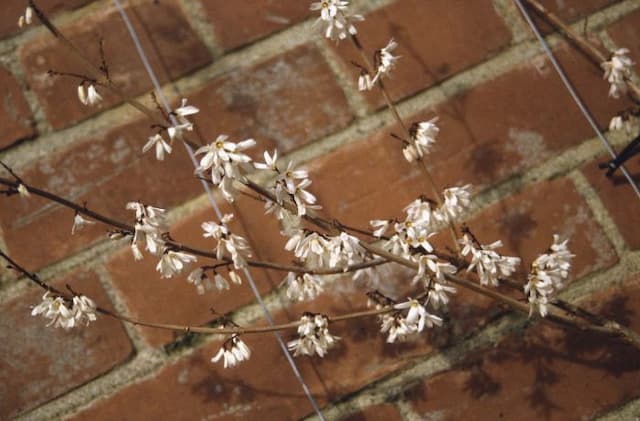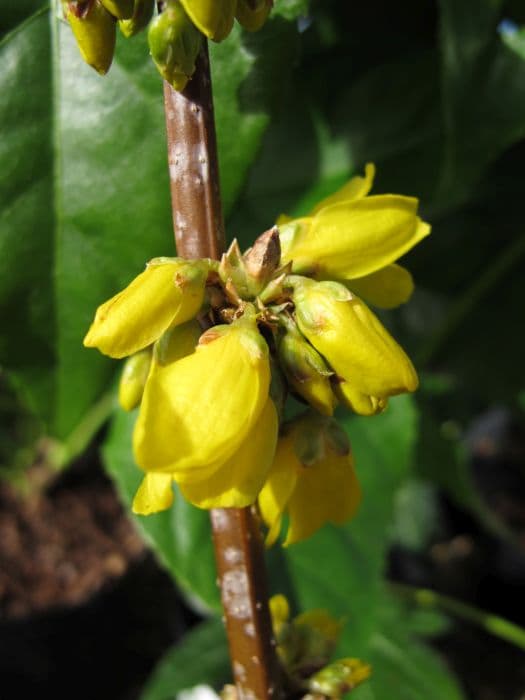Manna Ash Fraxinus ornus

ABOUT
The plant, commonly known as the flowering ash or manna ash, is adorned with pinnate leaves that typically have 5-9 leaflets per leaf. The foliage is bright green and turns to yellow or purple shades in the fall, creating an attractive display. Springtime brings dense clusters of creamy white flowers, making the plant stand out with its ornamental appeal. The flowers are small and fragrant, arranged in showy panicles that can fill the air with a pleasant scent. Once the flowering period is over, the plant produces winged fruits, often referred to as samaras or keys, which hang in clusters and can catch the light beautifully as they turn from green to brown. The bark of the plant is grey and can become furrowed with age, giving it texture and adding to its ornamental value. Overall, the flowering ash is a plant that brings seasonal interest with its lush leaves, fragrant springtime flowers, and distinctive fruits that can attract wildlife such as birds and serve as a charming visual highlight in the landscape.
About this plant
 Names
NamesFamily
Oleaceae
Synonyms
Manna Ash, Flowering Ash, South European Flowering Ash, Manna Tree
Common names
Ornus europaea, Fraxinus ornus var. microphylla, Fraxinus ornus var. italica, Fraxinus italica, Fraxinus excelsior var. ornus, Ornus rotundifolia, Ornus vulgaris, Fraxinus rotundifolia, Fraxinus carpinifolia, Fraxinus pallida, Fraxinus parvifolia.
 Characteristics
CharacteristicsLife cycle
Perennials
Foliage type
Deciduous
Color of leaves
Green
Flower color
White
Height
15-25 feet (4.6-7.6 meters)
Spread
15-25 feet (4.6-7.6 meters)
Plant type
Tree
Hardiness zones
5-8
Native area
Mediterranean
Benefits
 General Benefits
General Benefits- Ornamental Value: Fraxinus ornus, commonly known as Manna Ash, is often used in landscaping for its attractive appearance, especially its showy white flowers in spring.
- Shade Provider: The tree's canopy can create a cool, shaded area underneath, making it ideal for parks and gardens where people seek relief from the sun.
- Habitat for Wildlife: Manna Ash provides a habitat and food source for various wildlife species, including birds and insects.
- Soil Improvement: As a deciduous tree, it contributes to soil health by dropping leaves that decompose and enrich the soil with nutrients.
- Cultural Significance: In some cultures, the tree has historical uses and significance, which can be important for maintaining heritage and traditions.
- Erosion Control: Its root system can help stabilize the soil and prevent erosion, especially on slopes or in areas prone to soil loss.
- Economic Value: Manna Ash's ornamental characteristics make it valuable for horticulture markets, and its timber can be used for woodworking and carpentry.
 Medical Properties
Medical Properties- Expectorant: Fraxinus ornus, commonly known as Manna Ash, may be utilized for its expectorant properties in traditional medicine practices.
- Laxative: The manna, a sweet exudate derived from the bark, has been used for its laxative effects.
- Anti-inflammatory: Reports suggest that the plant might have anti-inflammatory properties, beneficial in reducing inflammation.
- Demulcent: The manna sap can also act as a demulcent, soothing irritated or inflamed tissues.
- Diuretic: Some historical references point to the use of parts of the plant as a diuretic, to help increase the passing of urine.
 Air-purifying Qualities
Air-purifying QualitiesThis plant is not specifically known for air purifying qualities.
 Other Uses
Other Uses- Fraxinus ornus, commonly known as manna ash, has bark that is traditionally used in tanning leather due to the presence of tannins which help in the transformation of animal skins into durable leather.
- The flowers of the manna ash can serve as a food source for pollinators such as bees, which can turn the nectar into honey with a unique flavor profile reflecting the characteristics of the tree.
- The dense wood of the manna ash is often utilized in the manufacturing of tool handles, sporting goods, and musical instruments due to its strength and elasticity.
- Wood from the manna ash is used in woodworking for the creation of fine furniture and decorative carvings, valued for its attractive grain and good working properties.
- Manna ash can be used for ornamental purposes in landscape gardening, being planted as a decorative shade tree for its attractive foliage and form.
- The sap of the tree contains a substance called 'manna' which can be refined into natural sugar substitutes or sweeteners, diverse from its medicinal usage.
- The manna ash produces a hard, robust wood that is suitable for flooring and interior joinery, offering durability and resisting wear.
- As part of environmental management, the manna ash plays a role in soil stabilization on slopes and helps to prevent erosion due to its extensive root system.
- The leaves of the manna ash are sometimes used as fodder for livestock, particularly in traditional farming systems where tree foliage provides a supplementary food source.
- The wood of manna ash, due to its flammability and good burning characteristics, is considered good quality firewood, and can be used for heating and cooking when dried properly.
Interesting Facts
 Feng Shui
Feng ShuiThe Manna Ash is not used in Feng Shui practice.
 Zodiac Sign Compitability
Zodiac Sign CompitabilityThe Manna Ash is not used in astrology practice.
 Plant Symbolism
Plant Symbolism- Resilience - The Fraxinus ornus, commonly known as the Manna Ash, is symbolically linked to resilience due to its hardy nature and ability to thrive in various conditions.
- Healing - Historically, Manna Ash's sap was used for medicinal purposes, symbolizing healing and the soothing of ailments.
- Protection - In some cultures, the Manna Ash was thought to ward off evil spirits, thus it represents protection and safety.
- Wisdom - Ash trees, in general, are often associated with wisdom and knowledge in various mythologies, and the Manna Ash shares this symbolic meaning.
- Renewal - The Manna Ash’s ability to regrow and recover symbolizes renewal and the cyclic nature of life.
 Water
WaterThe most common common name for Fraxinus ornus is Manna Ash. Manna Ash prefers even moisture and should be watered deeply, particularly during dry spells. In general, watering once a week with approximately 1.5-2 gallons per inch of trunk diameter at chest height is sufficient. During hot or windy weather, the frequency should be increased, and during cooler or rainy periods, it can be reduced. It is important to avoid overwatering, as Manna Ash does not tolerate standing water or overly wet soil.
 Light
LightManna Ash thrives in full sun to partial shade conditions. It performs best when planted in a location that receives direct sunlight for at least 6 hours a day. However, it can also tolerate some light shade, especially during the hottest parts of the day. A spot with morning sunlight and afternoon shade can help prevent scorching in regions with intense summer sun.
 Temperature
TemperatureManna Ash is hardy and can endure winter temperatures down to about -20°F, while its upper heat tolerance is around 100°F. The ideal temperature conditions for Manna Ash range from 60°F to 80°F. Being a deciduous tree native to temperate zones, it is well adapted to seasonal variations in temperature and can handle typical fluctuations within these ranges.
 Pruning
PruningPruning Manna Ash is important to maintain its shape, remove any damaged or diseased branches, and promote healthy growth. The best time for pruning is late winter or early spring before new growth begins. Pruning should be done sparingly and not more than once a year to avoid stressing the tree. Remove only dead or crossing branches and any growth that compromises the structure of the tree.
 Cleaning
CleaningAs needed
 Soil
SoilThe Manna Ash, or Fraxinus ornus, thrives in well-draining loamy soil with a neutral to slightly alkaline pH of around 6.5 to 7.5. A good soil mix for Manna Ash would include a combination of garden soil, compost, and perlite to ensure both nutrient richness and proper drainage.
 Repotting
RepottingManna Ash, also known as Fraxinus ornus, being a large tree, is not typically repotted as it is usually planted directly outdoors. However, if grown in a large pot, repotting may be done every 3-5 years to avoid the plant becoming root-bound.
 Humidity & Misting
Humidity & MistingManna Ash, or Fraxinus ornus, is adaptable but prefers moderate humidity levels. Maintaining the natural ambient outdoor humidity or slightly above average indoor humidity is generally sufficient.
 Suitable locations
Suitable locationsIndoor
Manna Ash is usually an outdoor tree; difficult to grow indoor due to size.
Outdoor
Plant Manna Ash in a sunny spot with well-draining soil and space to grow.
Hardiness zone
5-9 USDA.
 Life cycle
Life cycleFraxinus ornus, commonly known as flowering ash or manna ash, begins its lifecycle as a seed, which germinates when conditions of moisture and temperature are appropriate, usually in spring. Upon germination, the seedling emerges, developing a root system and a shoot that grows into a sapling. With adequate sunlight, water, and nutrients, the sapling gradually matures into a leafy, deciduous tree capable of withstanding various environmental conditions. After a few years, the tree reaches reproductive maturity, producing panicles of creamy-white, fragrant flowers in late spring which are pollinated by insects. Following pollination, the tree develops samaras, winged fruits that are dispersed by wind, facilitating the propagation of the species. The manna ash can live for several decades, undergoing cycles of growth, flowering, and fruiting within its lifespan.
 Propogation
PropogationPropogation time
Spring to Summer
The most popular method for propagating Manna Ash (Fraxinus ornus) is through seed sowing. Manna Ash seeds require stratification for successful germination, a process that involves simulating natural conditions that seeds must endure before germination. This typically requires mixing the seeds with slightly moist sand and storing them in a refrigerator for approximately 1-2 months at temperatures around 40 degrees Fahrenheit (4 degrees Celsius). After stratification, seeds can be sown in containers with well-drained soil in spring, just after the last frost. Seedlings often take several years to grow large enough to be transplanted. Manna Ash can also be challenging to grow from cuttings, therefore sowing seeds is the preferred method.








